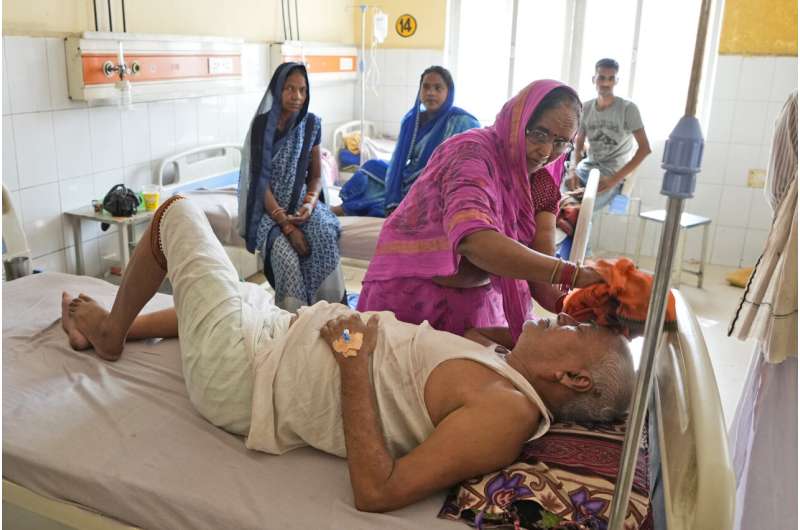This article has been reviewed according to Science X's editorial process and policies. Editors have highlighted the following attributes while ensuring the content's credibility:
fact-checked
reputable news agency
proofread
Days of sweltering heat, power cuts in northern India overwhelm hospitals as death toll climbs

A scorching heat wave in two of India's most populous states has overwhelmed hospitals, filled a morgue to capacity and disrupted power, forcing staff to use books to cool patients, as officials investigate a death toll that has reached nearly 170.
In the northern state of Uttar Pradesh, 119 people have died from heat-related illnesses over the last several days while neighboring Bihar state reported 47 fatalities, according to local news reports and health officials.
"So many people are dying from the heat that we are not getting a minute's time to rest. On Sunday, I carried 26 dead bodies," Jitendra Kumar Yadav, a hearse driver in Deoria town, 110 kilometers (68 miles) from Ballia, told The Associated Press.
Other residents said they were scared of going outside after midmorning.
The largest hospital in Ballia district in Uttar Pradesh is unable to accommodate more patients. Officials said the morgue was full after 54 people, all of whom were elderly suffering from various health issues, died during the heat wave. Some families were asked to take the bodies of their relatives home.
On Sunday, the state health minister, Brajesh Pathak, said a two-member team will look into what caused the large number of deaths and investigate how many of them are directly related to heat.
While northern regions of India are known for sweltering heat during the summer months, temperatures have been consistently above normal, according to the Indian Meteorological Department, with highs reaching 43.5 degrees Celsius (110 degrees Fahrenheit). A heat wave is declared in India if temperatures are at least 4.5 C above normal, or if the temperature is above 45 C (113 F).
"We have been issuing heat wave warnings for the past few days," said Atul Kumar Singh, a scientist at the IMD.
Despite the warnings, government officials did not ask people to brace for the heat until Sunday, when the death toll began to increase.
Adding to the heat stress are consistent power outages across the region, leaving people with no running water, fans or air conditioners.
Uttar Pradesh Chief Minister Yogi Adityanath said the government was taking measures to ensure an uninterrupted power supply. He urged citizens to cooperate and use electricity judiciously.
"Every village and every city should receive adequate power supply during this scorching heat. If any faults occur, they should be promptly addressed," he said Friday night in a statement.
Inside the Ballia district hospital, the chaotic scenes were reminiscent of the coronavirus pandemic, with families and doctors scrambling as many patients required urgent attention. The corridors smelled of urine, garbage and medical waste, and hospital walls were stained with betel leaf spit.
"All our staff has been here for three days straight and are completely overworked," said Dr. Aditya Singh, an emergency medical officer.
The wards in the hospital had no functioning air conditioners, and cooling units that were installed were not working properly due to power fluctuations. Attendants were fanning patients with books and wiping their sweat in an attempt to keep them cool.
Officials said more severe cases were being shifted to hospitals in bigger cities nearby such as Varanasi, and more doctors and medical resources were being sent to the district hospital to deal with the heat-induced crisis.
Climate experts say that heat waves will continue and India needs to prepare better to deal with their consequences. A study by World Weather Attribution, an academic group that examines the source of extreme heat, found that a searing heat wave in April that struck parts of South Asia was made at least 30 times more likely by climate change.
"Plans for dealing with heatwaves are essential for minimizing their effects and preserving lives. These plans include all-inclusive approaches to dealing with high heat occurrences, such as public awareness campaigns, the provision of cooling centers, and healthcare assistance," said Aditya Valiathan Pillai, an associate fellow at a New Delhi-based think-tank, Centre for Policy Research.
© 2023 The Associated Press. All rights reserved. This material may not be published, broadcast, rewritten or redistributed without permission.



















